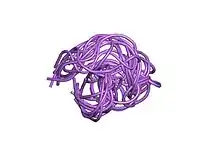| Granin (chromogranin or secretogranin) | |||||||||
|---|---|---|---|---|---|---|---|---|---|
 Structure of SS-cyclized catestatin fragment from chromogranin A.[1] | |||||||||
| Identifiers | |||||||||
| Symbol | Granin | ||||||||
| Pfam | PF01271 | ||||||||
| InterPro | IPR001990 | ||||||||
| PROSITE | PDOC00365 | ||||||||
| SCOP2 | 1cfk / SCOPe / SUPFAM | ||||||||
| OPM superfamily | 282 | ||||||||
| OPM protein | 1lv4 | ||||||||
| |||||||||
Granin (chromogranin and secretogranin) is a protein family of regulated secretory proteins ubiquitously found in the cores of amine and peptide hormone and neurotransmitter dense-core secretory vesicles.[2]
Function
Granins (chromogranins or secretogranins) are acidic proteins and are present in the secretory granules of a wide variety of endocrine and neuro-endocrine cells. The exact function(s) of these proteins is not yet settled but there is evidence that granins function as pro-hormones, giving rise to an array of peptide fragments for which autocrine, paracrine, and endocrine activities have been demonstrated in vitro and in vivo. The intracellular biochemistry of granins includes binding of Ca2+, ATP and catecholamines (epinephrine, norepinephrine) within the hormone storage vesicle core. There is also evidence that CgA, and perhaps other granins, regulate the biogenesis of dense-core secretory vesicles and hormone sequestration in neuroendocrine cells.
Structure
Apart from their subcellular location and the abundance of acidic residues (Asp and Glu), these proteins do not share many structural similarities. Only one short region, located in the C-terminal section, is conserved in all these proteins. Chromogranins and secretogranins together share a C-terminal motif, whereas chromogranins A and B share a region of high similarity in their N-terminal section; this region includes two cysteine residues involved in a disulfide bond.
There are considerable differences in the amino acid composition between different animals. Commercial assays for measuring human CGA can usually not be used for measuring CGA in samples from other species. Some specific parts of the molecule have a higher degree of amino acid homology and methods where the antibodies are directed against specific epitopes can be used to measure samples from different animals.[3] Region-specific assays measuring defined parts of CGA, CGB and SG2 can be used for measurements in samples from cats and dogs.[4][5][6][7]
Members
Chromogranins
- chromogranin A (CgA)
- chromogranin B (CgB)
|
| ||||||||||||||||||||||||||||||||||||||||||||||||||||||||||||
Secretogranins
- secretogranin II (SgII) (see also secretoneurin)
- secretogranin III (SgIII)
- secretogranin V (SgV)
|
|
| ||||||||||||||||||||||||||||||||||||||||||||||||||||||||||||||||||||||||||||||||||||||||||
Extended group
Some other proteins are also proposed to belong to the granins based on their physico-chemical properties. These include NESP55 (SgVI), VGF (SgVII), and ProSAAS (SgVIII).[8]
References
- ↑ Preece NE, Nguyen M, Mahata M, Mahata SK, Mahapatra NR, Tsigelny I, O'Connor DT (April 2004). "Conformational preferences and activities of peptides from the catecholamine release-inhibitory (catestatin) region of chromogranin A". Regulatory Peptides. 118 (1–2): 75–87. doi:10.1016/j.regpep.2003.10.035. PMID 14759560. S2CID 43517955.
- ↑ Huttner WB, Gerdes HH, Rosa P (January 1991). "The granin (chromogranin/secretogranin) family". Trends in Biochemical Sciences. 16 (1): 27–30. doi:10.1016/0968-0004(91)90012-K. PMID 2053134.
- ↑ Stridsberg M, Angeletti RH, Helle KB (June 2000). "Characterisation of N-terminal chromogranin A and chromogranin B in mammals by region-specific radioimmunoassays and chromatographic separation methods". The Journal of Endocrinology. 165 (3): 703–14. doi:10.1677/joe.0.1650703. PMID 10828855.
- ↑ Stridsberg M, Pettersson A, Hagman R, Westin C, Höglund O (June 2014). "Chromogranins can be measured in samples from cats and dogs". BMC Research Notes. 7 (1): 336. doi:10.1186/1756-0500-7-336. PMC 4055239. PMID 24899097.
- ↑ Höglund OV, Hagman R, Stridsberg M (27 March 2015). "Chromogranin A and cortisol at intraoperative repeated noxious stimuli: Surgical stress in a dog model". SAGE Open Medicine. 3: 2050312115576432. doi:10.1177/2050312115576432. PMC 4679230. PMID 26770773.
- ↑ Srithunyarat T, Höglund OV, Hagman R, Olsson U, Stridsberg M, Lagerstedt AS, Pettersson A (August 2016). "Catestatin, vasostatin, cortisol, temperature, heart rate, respiratory rate, scores of the short form of the Glasgow composite measure pain scale and visual analog scale for stress and pain behavior in dogs before and after ovariohysterectomy". BMC Research Notes. 9 (1): 381. doi:10.1186/s13104-016-2193-1. PMC 4969733. PMID 27484122.
- ↑ Srithunyarat T, Hagman R, Höglund OV, Olsson U, Stridsberg M, Jitpean S, Lagerstedt AS, Pettersson A (January 2017). "Catestatin and vasostatin concentrations in healthy dogs". Acta Veterinaria Scandinavica. 59 (1): 1. doi:10.1186/s13028-016-0274-8. PMC 5210291. PMID 28049540.
- ↑ Bartolomucci A, Possenti R, Mahata SK, Fischer-Colbrie R, Loh YP, Salton SR (December 2011). "The extended granin family: structure, function, and biomedical implications". Endocrine Reviews. 32 (6): 755–97. doi:10.1210/er.2010-0027. PMC 3591675. PMID 21862681.
External links
- Chromogranins at the U.S. National Library of Medicine Medical Subject Headings (MeSH)